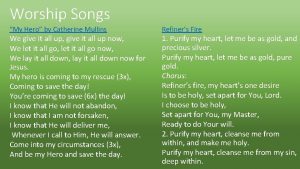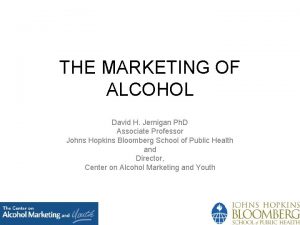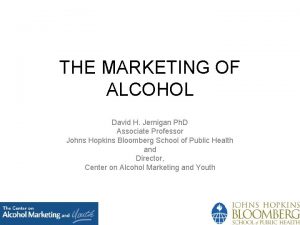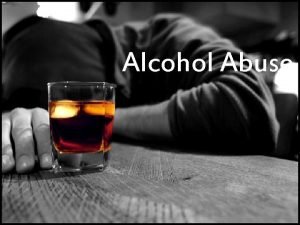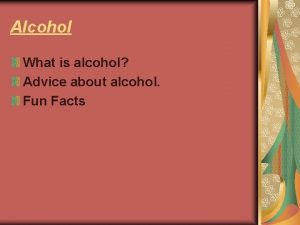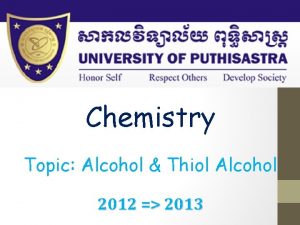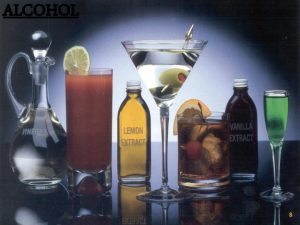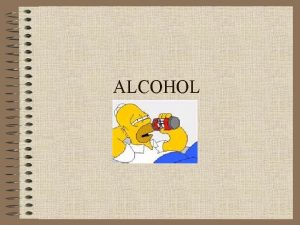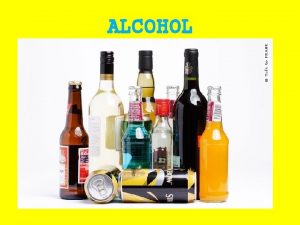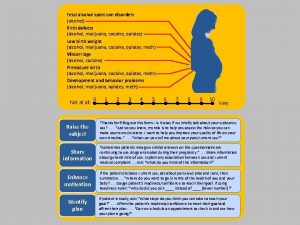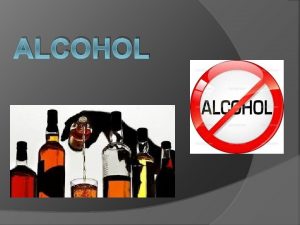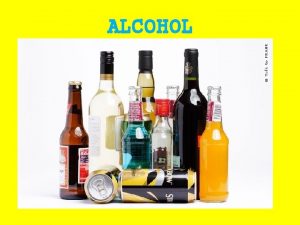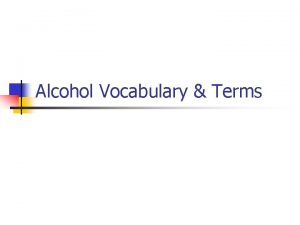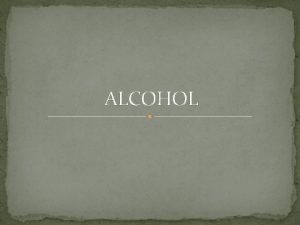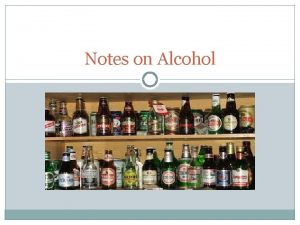THE MARKETING OF ALCOHOL David H Jernigan Ph
























- Slides: 24

THE MARKETING OF ALCOHOL David H. Jernigan Ph. D Associate Professor Johns Hopkins Bloomberg School of Public Health and Director, Center on Alcohol Marketing and Youth

Acknowledgments • Michele Simon, J. D. , Research and Policy Director, The Marin Institute • Amanda Stewart, B. S. , M. P. H. student, Johns Hopkins Bloomberg School of Public Health

Alcohol marketing and NCDs • What is the connection? – Patterns of light to moderate drinking without heavy drinking occasions may be protective – Heavy drinking patterns (>50 g. /day for women, >60 g. /day for men) increase risk of a wide range of adverse health effects – Drinking patterns established early in life – Alcohol marketing most influential on young people

Youthful drinking and heavy drinking • Young people who begin drinking before age 15 are four times more likely to become alcohol dependent than those who wait until 21 (Grant and Dawson 1997) • Incidence of the onset of alcohol dependence peaks at age 18 – risk of dependence very low after age 25. (Li et al. 2004)

Adverse consequences of early onset • In the US, compared with persons who wait until age 21 to start drinking, young people who start drinking before age 15 are: – Four times more likely to develop alcohol dependence (Grant and Dawson 1997) – Six times more likely to be in a physical fight after drinking; – Greater than six times more likely to be in a motor vehicle crash because of drinking; – Almost five times more likely to suffer from other unintentional injuries after drinking (Hingson et al. 2009).

The public health interest • Strong public health interest in delaying onset of drinking as well as any binge occasions. • In the US, more than 90% of alcohol consumed by young people is drunk on binge occasions. • Exposure to alcohol marketing increases likelihood of early onset of drinking and, if already drinking, of heavier consumption. (Anderson et al. 2009)

Longitudinal studies connecting youth exposure to drinking • Television advertisements (Collins et al. 2007, Snyder et al. 2006, Stacy et al. 2004, Morganstern et al. 2011) • Alcohol ads in magazines (Collins et al. 2007, Snyder et al. 2006) • Alcohol ads on billboards (Snyder et al. 2006, Pasch et al. 2007) • In-store beer displays (Collins et al. 2007) • Beer concessions at sporting events (Collins et al. 2007) • Per capita spending on alcohol advertising in their media market (Snyder et al. 2006) • Alcohol use in movies (Sargent et al. 2006) • Ownership of alcohol promotional items (Mc. Clure et al. 2006, Henriksen et al. 2008)

Alcohol industry self-regulation Beer advertising and marketing materials should not…claim or represent that individuals cannot obtain social, professional, educational, athletic, or financial success or status without beer consumption.

Alcohol industry self-regulation • Beverage alcohol advertising and marketing materials should not be associated with anti-social or dangerous behavior.

What the Center on Alcohol Marketing and Youth (CAMY) does • Answers the question: how much alcohol advertising do kids see? • Tracks alcohol advertising on TV and radio and in magazines • Uses standard industry sources – Neilsen, Arbitron, etc. – to measure the audiences for that advertising. • Shows that over and over again, kids are exposed to more alcohol advertising person than adults.

Youth exposure to alcohol advertising: magazines In 2008, compared to adults 21 and over, youth ages 12 -20 saw per capita… • • • 10% more beer ads 16% more ads for alcopops 73% fewer wine ads The overwhelming majority of youth exposure – 78% came from ads placed in magazines with disproportionate youth audiences.

Youth Exposure to Alcohol Ads on U. S. Television • In 2009, 315, 581 alcohol product commercials appeared on U. S. television. • Underage youth ages 12 -20 were more likely than legalage adults on a per capita basis to have seen 67, 656 of them, or about 21%. • These ads accounted for more than 44% of youth exposure to alcohol advertising on television. • From 2001 to 2009 – the number of television alcohol ads seen by the average 12 to 20 year-old increased by 69%, from 217 per year to 366 per year.

Marketing alcohol to women • Girls much more overexposed than boys – Magazines, 2002: • Girls saw 68% more beer advertising, 95% more alcopops advertising per capita than women – Radio, 2009 • In five of 11 markets measured – Washington, Philadelphia, Houston, San Francisco, and Detroit – underage girls were more exposed to alcohol advertising than adult women, age 21 and above.

“Targeting” youth? • Cable television study: – Census of 608, 591 advertisements on cable television, 2001 to 2006 – each one-point increase in the percentage of the audience that was adolescent was associated with more beer (+7%), spirits (+15%), and alcopop (+22%) ads per viewerhour, but fewer wine (-8%) ads (P<. 001 for all). (Chung et al. , American Journal of Public Health, 2009)

Trends in alcohol marketing • New products • Digital marketing • Alcohol as a health food • Stakeholder marketing

“Alcopops” In Nova Scotia:

How popular are alcopops among kids? • Most popular with the youngest drinkers. • 78% of current 8 th grade drinkers (past 30 days) drank alcopops in the past 30 days. • 71% of current 10 th grade drinkers (past 30 days) drank alcopops in the past 30 days. • 65% of current 12 th grade drinkers (past 30 days) drank alcopops in the past 30 days. • 42% of current drinkers, age 19 to 30, drank alcopops in the past 30 days. Source: MTF 2004

Most popular with females in every age group • Teenage girls (33%) were more likely to prefer alcopops compared to teenage boys (27%) • Girls saw 95% more magazine advertising for alcopops than legal-age women (Arch Pediatr Adolesc Med 2004) • Exposure to girls of advertising for alcopops increased 216% from 2001 -2002

Alcoholic energy drinks Research findings on effects of alcoholic energy drinks on the drinker: • Subjective perceptions of intoxication decreased (i. e. headache, weakness, dry mouth, perception of impaired motor coordination) compared to effects of drinking alcoholic non-energy drink • However, according to objective tests, motor coordination and visual reaction time were still just as impaired. (ACER 30: 598 -605, 2006) • AED drinkers more likely to engage in dangerous activities


Alcoholic energy drinks • Caffeinated alcoholic beverages declared adulterated product by FDA in November 2010 – banned from the market by mid. December • Still available in Canada:

The Latest in Alcopops: High Alcohol Flavored Malt Beverages • “Binge in a can” – Same packaging as alcoholic energy drinks – Same huge serving size – 23. 5 ounces of 12% alcohol – Similar dangers to youth • Equivalent of 5 drinks, sold as single serving • Category grossed $959 million in 2010 (WSJ)

New products: Nova Scotia • Alcoholic chocolate milk…

New products: alcoholic whipped cream • “Whipahol”, “Whipped Lightning”, “Get Whipped” • One can has alcohol content of 3 beers (18. 5% alcohol) • Flavors like white chocolate raspberry and strawberry colada
 Dr christopher jernigan
Dr christopher jernigan Dennis jernigan you are my hero
Dennis jernigan you are my hero Secondary alcohols
Secondary alcohols Primary alcohol oxidation
Primary alcohol oxidation Hình ảnh bộ gõ cơ thể búng tay
Hình ảnh bộ gõ cơ thể búng tay Lp html
Lp html Bổ thể
Bổ thể Tỉ lệ cơ thể trẻ em
Tỉ lệ cơ thể trẻ em Chó sói
Chó sói Tư thế worms-breton
Tư thế worms-breton Chúa sống lại
Chúa sống lại Các môn thể thao bắt đầu bằng tiếng nhảy
Các môn thể thao bắt đầu bằng tiếng nhảy Thế nào là hệ số cao nhất
Thế nào là hệ số cao nhất Các châu lục và đại dương trên thế giới
Các châu lục và đại dương trên thế giới Công thức tiính động năng
Công thức tiính động năng Trời xanh đây là của chúng ta thể thơ
Trời xanh đây là của chúng ta thể thơ Cách giải mật thư tọa độ
Cách giải mật thư tọa độ 101012 bằng
101012 bằng độ dài liên kết
độ dài liên kết Các châu lục và đại dương trên thế giới
Các châu lục và đại dương trên thế giới Thể thơ truyền thống
Thể thơ truyền thống Quá trình desamine hóa có thể tạo ra
Quá trình desamine hóa có thể tạo ra Một số thể thơ truyền thống
Một số thể thơ truyền thống Cái miệng nó xinh thế chỉ nói điều hay thôi
Cái miệng nó xinh thế chỉ nói điều hay thôi Vẽ hình chiếu vuông góc của vật thể sau
Vẽ hình chiếu vuông góc của vật thể sau

